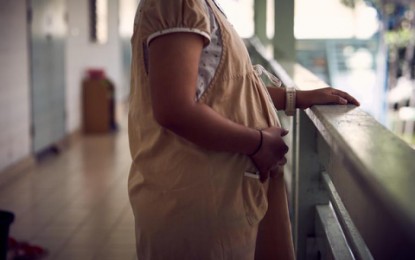
LIFE-CHANGING. President Rodrigo Duterte signed Executive Order 141 on June 25, 2021 to implement measures that will address the root causes of the rising number of adolescent pregnancies. Among Filipinos aged 10 to 19, there were about 495 live births per day in 2019, according to the Philippine Statistics Authority. (Photo courtesy of UNICEF)
MANILA – President Rodrigo Duterte’s signing of Executive Order (EO) 141, which aims to address the root causes of the rising number of adolescent pregnancies, will hopefully spur the creation of relevant laws that will address the situation that has been labelled an “urgent priority”.
The Commission on Population and Development (PopCom) chief Juan Antonio Perez III told reporters on Thursday they hope significant legislation will come out after EO 141.
“Complementing the action of President Duterte, his signing of EO 141 will hopefully draw a positive response from Congress and the Senate to address gaps in family planning and reproductive health services among minors who have become parents, or are pregnant,” he said.
Perez said they are thankful for the EO as it manifests the national government’s deep concern for the most vulnerable during this pandemic.
“They include minors who had unplanned or unintended pregnancies, which lead to the most vulnerable single-parent families amid the pandemic,” he said.
A 2018 report by the United Nations Children’s Fund (UNICEF) showed that while adolescent birth rates have declined globally, they have remained generally stagnant or even increased in Southeast Asia, with wide-ranging variations between countries.
The average adolescent birth rate in the region was 47 births per 1,000 females aged 15 to 19, higher than the average of 35 in South Asia and close to the global average of 50, according to the UNICEF report.
The UN agency responsible for providing humanitarian and developmental aid to children worldwide also shared that highest adolescent birth rates at the country level were seen in Lao (94), Cambodia (57), Thailand (50), Indonesia (48), and the Philippines (47).
“A striking number of young girls become pregnant without having planned to or without having had control of their pregnancy. When an adolescent girl becomes pregnant, her life changes forever. Her schooling often gets disrupted, or ends altogether, her prospects of a job dim, the health hazards due to complications from pregnancy and childbirth are huge and often fatal,” Wivina Belmonte, UNICEF deputy regional director for East Asia and the Pacific said. “The issues are complex and challenging to address. Good solutions come from collaboration, co-creation, and adolescent-centered approaches.”
In 2019, the Philippines recorded 180,916 live births in the 10 to 19 age group, or about 495 live births per day, according to the Civil Registration and Vital Statistics System of the Philippine Statistics Authority.
The PopCom Board of Commissioners, led by National Economic and Development Authority Secretary Karl Kendrick Chua, said the issue of teenage pregnancies is an urgent priority.
"The action of the President effectively focuses the attention of the government on the issue of pregnancies among adolescents in the Philippines," Perez also said in a statement.
PopCom, as one of the EO implementers, is directed “to continue to educate leaders, parents, and other community members about evidence-based strategies to reduce, if not eliminate, adolescent pregnancy, and improve adolescent reproductive health”.
“The PopCom shall consolidate a Comprehensive Action Plan Towards the Prevention of Adolescent Pregnancies the different initiatives of all government agencies and institutions,” the EO read. (PNA)
